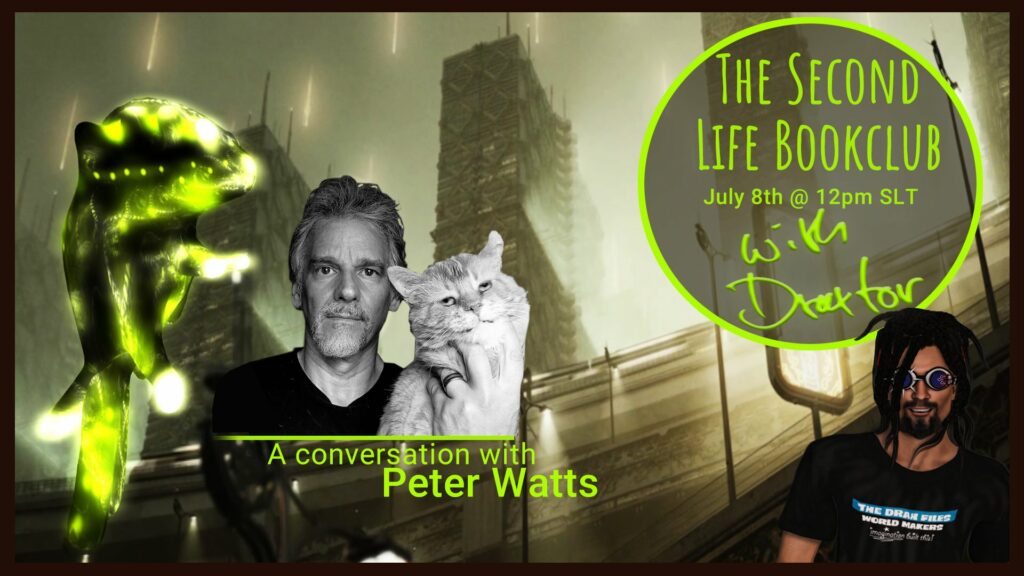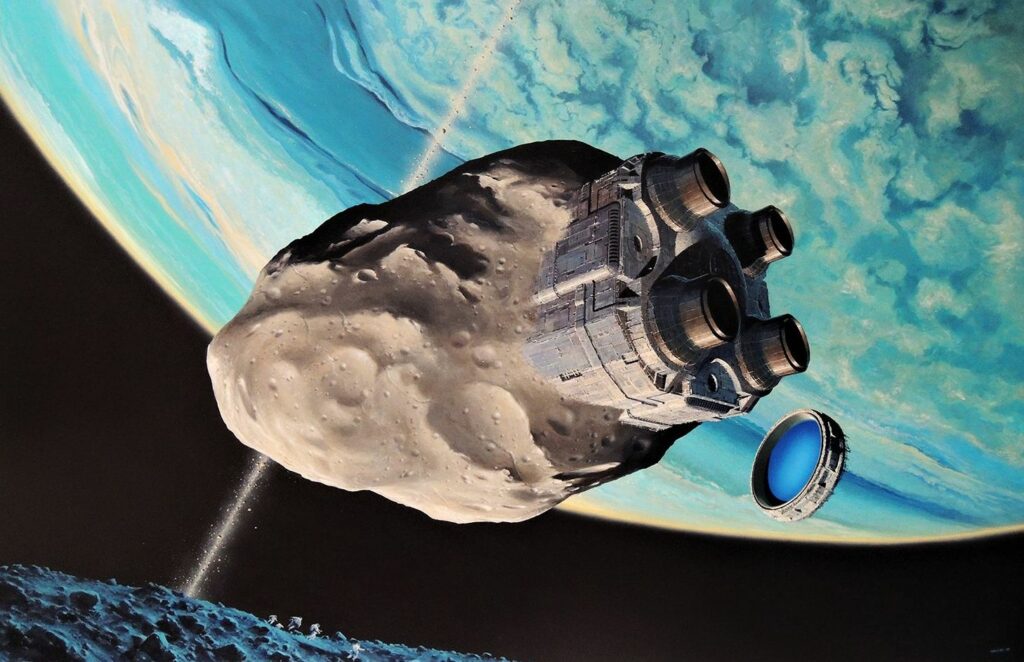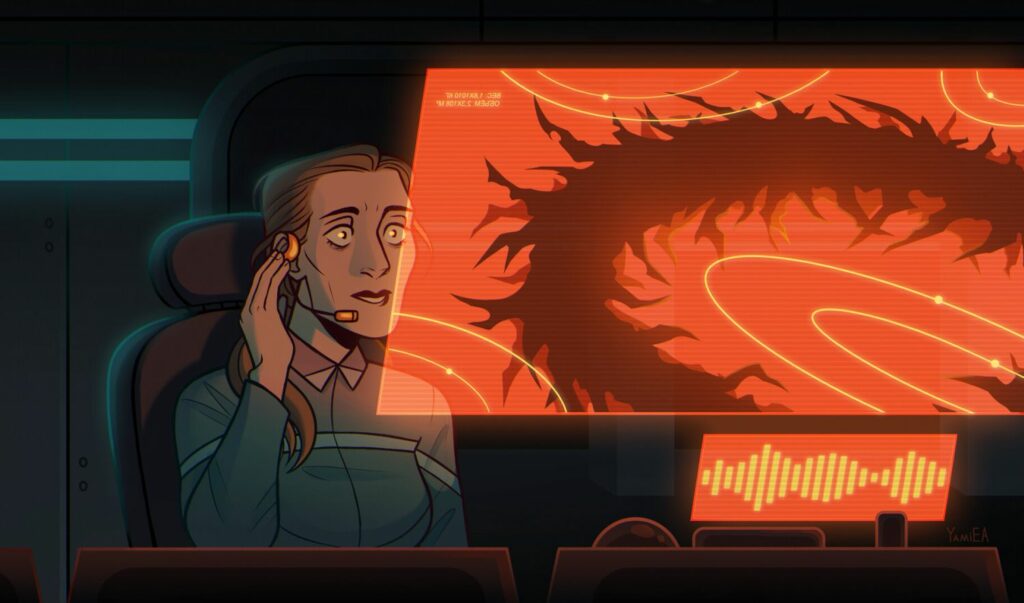Art, Interviews, and Second Life.
For some reason, my travel plans have been severely curtailed over the past few months. I have, however, been all over the place online: interviewed by Julie Nováková as one of the contributors to her Strangest of All anthology (fair warning, the video on my end is Chunky Pixel Soup); doing the inaugural AMA at WhatShouldIReadNext.com (although I think you might need a membership to access it); joining in with Torill Kornfeldt, Jessica Abbott, and Adrian Tchaikovsky do do an online panel moderated by Anna Davour on Why Spiders Are Cool; an epic and wide-ranging appearance over at Podcast Picnic; even, if you want to go way back to when I was still talking about imminent pandemics in the future tense, the very first Masters of the Universe podcast from way back in December of 2019. (You might also want to keep your eye on the literary critique site Big Echo for an upcoming interview that goes into some unexpected—to me, anyway—places.)
I never got around to announcing most of these before now, even though some of them have been out in the wild for months; but there they are, if Covid has left you with too much time on your hands and you want to catch up. I’m getting out in front of my next appearance in advance, though—albeit barely— because it’s a significant departure from the usual podcast or written interview: I’m going to be appearing this Wednesday on Draxtor Despres’ Second Life Book Club in, er, Second Life.

Yeah, I know. I didn’t think that was still a thing either. But SL abides, and in fact continues to host a thriving community, and Drax—well, he’s cool people. Way back in the Before Time he interviewed my buddy Karl Schroeder in Sansar’s VR environment: since moving over to SL his Book Club has really taken off. I’ve actually appeared in once before, as a guest heckler at Kelly Robson‘s interview; you might not have recognized me even if you were there, though, because I manifested as a Coronavirus (too soon?). This time I’m center stage, and I’ll be wearing the skin of a bioluminescent alien cephalopoid.
Now that I’ve bent over backward and told you about the event before it’s even happened, the least you can do is show up. Wednesday, July 8, 12pm Pacific (or as the natives call it, perhaps a bit to preciously: “Second Life Time”).
*
While I’m in the throes of Covid Cleaning, I might as well clear out the current fan-art backlog. Scattered around the various galleries you’ll find 21 new pieces (24 if you count the detail frames from the new Freeze-Frame Manchu cover as separate works. One new addition to Rifters; four in Sunflowers; eighteen in Blindopraxia. I continue to be humbled and amazed by the range and the quality of this stuff, but for the benefit of any linkophobes in the audience I present a sample of the new work here.














That Blindsight poster is amazing.
Have you ever gotten an offer to turn Blindsight into a graphic novel? I suddenly think it would work amazingly.
Seems a transcript of your AMA is freely available here: https://www.whatshouldireadnext.com/blog/the-almost-complete-peter-watts-ama-transcript
If only that Blindsight poster was announcing a film or TV series…
BTW: read your Crysis: Legion book. Enjoyed your thought provoking take on the setting.
Blue-red art with Jukka is miscredited, the credit goes fully to https://twitter.com/dogtagedagain/status/1230118472543342593
Hello! Thank you very much for all the lovely comments about my drawings! I also have more of them on my artstation but mostly black and white sketches.
Also I want pointed out that the art with floated Jukka surrounded by blood belongs to @dogtagedagain from twitter
It is. And there’s another one in the gallery that’s just as mindblowing.
I have not. I got graphic-novel nibble about Starfish, but the guy was pretty obviously a huckster.
Well, something is up with the rights. But I’m not allowed to talk about it.
It ain’t art, but that book is a source of guilty pride to me.
Fuck fuck fuck. My mistake. Fixing it on the post even as I type, will fix in the gallery first thing tomorrow. Don’t know how I mixed that up.
Thanks for the catch. I just hope лич ильич isn’t too offended.
You’re more than welcome. Yours is a really fresh interpretation.
Yeah, Alex just barely beat you to that punch. I’m really embarrassed. I’m not on Twitter, so I don’t even know where I got that illo from. Can’t find dogtagedagain on DeviantArt (although you’re there).
Awww! Thanks again!
Ah, I see it now!
Unfortunately I don’t know anything about dogtagedagain’s others art accounts beside Twitter, so I couldn’t help here :с
Hello, Mr.Watts, just stopped by to say I`m not offended at all, those little mistakes could happen to anyone all things considered.
It has been a pleasure.
>Is it my imagination, or do the Frawnsh absolutely rock at SciFi art?
It’s the land of Jean “Moebius” Giraud, just to name the biggest shoes to fill, so I guess they’re kinda obligated to.
Hope it’s okay if I add a link to Strangest of All: https://www.julienovakova.com/strangest-of-all/
People here on your ‘crawl likely have a penchant for SF accompanied by science, so they might like it.
Thank you. And “Serpens” is a much catchier handle—at least in English—than “лич ильич”, so I think I’ll update the gallery again.
I really like your use of the constrained palette. That picture really pops.
Not at all. In fact I did you one better and embedded the link in the actual post.
Who do I have to kill to get you to publish Omniscience? Just say the word, and they disappear within 3 days.
About halfway through listening to Masters of the Universe, and wanted to pop on here with a quick note: it seems as if your take on the intersections between entropy and life are another example of your inherent optimism getting the better of you again. Most current understandings (that I’m aware of) on the topic regard life as an inherently entropy-INCREASING phenomenon. And I do mean inherently: Mike Russell plainly states that ‘the purpose of life is to hydrogenate carbon dioxide.’
https://www.labroots.com/trending/videos/10338/what-is-the-purpose-of-life-chemically-speaking
http://tuvalu.santafe.edu/~desmith/educ_talks.html
This should have been obvious from the beginning, of course. Solar energy leaves the atmosphere much more disordered than it enters, and the conversion engine is life. Indeed, evolution can be seen as a process by which organisms identity energy ripe for exploitation and exploit it; that exploitation always involves increased entropy.
Does it have to be just one?
Nah, that’s not optimism. That’s just me ignoring what goes on outside a very small box.
You’re right, of course. One of the first things you learn as an undergrad is that Life is an entropy-generating machine; the price for the highly-ordered, low-entropy state of the organism is a big mess o’increasing entropy everywhere else. But on that strictly local level— ignoring stars and hurricanes— life comprises these knots of complexity where entropy increases more slowly because of the greater complexity of the path the energy has to traverse. The more complex something is, the longer it takes to break back down to its building blocks simply because there’s more deconstruction to be done. As I understand it, anyway.
But yeah, that local foot on the entropic brakes is dwarfed by the entropy increase required to build the foot in the first place. I still revel in visions of little bubbles of complexity hanging on after most of the universe has gone to heat death, and I think it’s a cool idea. But you’re absolutely right; it’s pure wishful thinking. The numbers don’t add up.
Also that’s a very neat website you linked to. I will be visiting it again.
It’s important to remember that entropy and complexity are different. The best example I’ve heard to demonstrate this is concept: pour coffee in a glass, two-thirds full, then slowly add heavy cream to fill.
The early state of the glass is low entropy, low complexity: two bands of colour.
The mid state, where tendrils of the cream have penetrated the coffee in nonuniform and interest ways, is medium entropy, medium complexity.
Take a spoon and stir. That’s high entropy – but low complexity.
These are the same stages that the universe goes through. Life can only exist in the middle of the lifecycle of the universe, when both entropy and complexity are in a state conducive to producing the universe we see around us. We are absolutely expressions of our particular moment in the universe, even as we hasten its end with every breath we take. That’s a romantic enough image for me.
Ah, I’m an idiot: the coffee example is repeated in the same video series. Could’ve saved some time by just linking it:
https://www.youtube.com/watch?v=MTFY0H4EZx4
Highly recommend the Podcast Picnic interview to all. Intense, personal, funny, all the things I look for in a quality interview.
Looking at alternative cover for “Firefall” I remember that the first impression of Theseus was completely opposite to the shiny spindle I see now everywhere. More like the precognition image, echo of things to come, it was akin to a dark, spiny and spiky club with symmetrically protruding subsystems. Mushroom shaped (much like Avatar Titan or Kadeshi Mothership), with most of it’s vital systems concentrated under the cap, it does not need to have regular reflective surface so far from the star, only Whipple shielding and radiation screens against interstellar space, mostly grey and charcoal-black.
Rorschach, OTOH, left no lasting impression, it is too enigmatic for an ordinary human mind to comprehend, at least at first attempt. Years later, I imagined the giant interstellar beasts, travelling in darkness between the stars for millions of years, completely alien to everything that warm areas around stars offer to life – IIRC, the book mentions that this ETI may be of this type.
I’ve always had a gut-level dissonance with that distinction, to be honest. A Mandelbrot fractal looks infinitely complex, and yet can be described by a very simple iterative equation. A completely random collection of particles takes a lot of information to describe it, you need 3D coordinates for each and every particle. A part of my gut feels that the random cloud has to be more complex because it takes so much more information to describe— and yet that degree of computational demand is also a metric of high entropy.
In between the endlessly-repeating salt crystal and the cloud of inert gas at heat death you get warm squishy things with GI tracts.
Why, thank you.
I have to admit that I kinda cringe to hear myself talk about ecosystem growth as “10-12%” and then “lower than inflation at the time”. That number’s way too high; I was just trying to pull a small number out of my ass to illustrate how unsustainable clear-cutting makes more capitalistic sense than sustainable forestry, but I pulled from too high up.
Just waiting for someone to squint at that number and tell me I don’t know what I’m talking about. Again.
You are exactly right. The book describes a smooth radiation-proof carapace sheathed over all that architecture; it would basically look like a rubber egg stretched lengthways, with a drive section sticking out the back end. All the inflatable habs attached to the spine exist inside this cavernous space between the spindle and the carapace, and the rest of that space can be used as a cargo hold.
But man, that would look boring.
Which is why, if you look at the various authorized diagrams of Theseus out there (of which I think there are two), you’ll see ass-covering annotations like “carapace not shown” and “carapace docking assembly”. The conceit is that there is a carapace, but it’s not shown to better highlight the axial morphology.
Which is great for diagrams, not so much for cover art that actually shows the ship on approach. That’s artistic license, because, you know. Boring.
Fuck this is cool.
I don’t think that’s quite right. If you want to slow down entropy you’d be better off just having everything be rocks or crystals. Something stable and low entropy that takes a long while to break down. Living things are much more dynamic and chaotic and suck the potential energy right out the sunrays hitting us.
I think it’d be more accurate to describe living worlds as places where entropy increases even faster, although I can’t exactly describe why because my thermodynamics knowledge kinda sucks. Might open up a book from undergrad later xd.
I really enjoyed the Podcast Picnic episode, thanks! Your apology letter was PHENOMENAL. I’m glad you could make such brilliant art out of such a horrible situation.
The episode would have been better with more sea cucumber, though.
Scrambler simulator just released:
https://www.youtube.com/watch?v=rTCheRo9Md4
Rich,
Totally transports the hopelessness of the situation for a mere mortal in the firefall universe.
Just dropping by for an OT comment, because I was thinking the other day about Incorruptible and pandemics and mRNA vaccines, and it occurred to me to wonder: what if the first COVID vaccine to get approved and into production was based on a novel technology that’s never been used a human vaccine before, something that’s so dependent on refrigeration that it’s useless outside the rich countries and enclaves of the owner class in poorer ones, so it never gets given to the people who don’t use much stuff to get by. In a few years beyond the time horizon of the clinical trials, after the vaccine’s been administered to most of the world’s biggest net carbon emitters, it turns out that tricking your own cells into producing antigens is not such a smart idea after all: bizarre new autoimmune disorders start mowing down the COVID-immune. Enough are incapacitated fairly promptly that collapse and a gigadeath ensue, but large-scale fossil fuel extraction and consumption are drastically curtailed and the world remains survivable for human societies. At about that point I got to where I was driving and stopped thinking about it, and maybe that would have been it were it not for the news today.
Where do you get this stuff from? Most vaccines need refrigeration.
This is impossible because mRNA quickly gets degraded inside cells
@Tran Script:
There’s “refrigeration” as in “needs to be kept on wet ice all the time” and then there’s “needs to be flash-frozen as the last step in preparation and thawed within minutes of use.” Not that I know of any particular technology that meets that last requirement, but we are talking in the comments of a SF writer’s blog.
As for mRNA degradation, sure. And the immune system is so completely well-understood that we can be certain that causing people’s own cells to express foreign antigens won’t have any dangerous effect that don’t manifest immediately! The immune system never mounts any delayed responses to anything!
I mean this is pretty much what a virus already does isn’t it? With the exception that instead of budding viral particles, the antigen just sits in the membrane or something (if it’s not on MHC I).
I mean I could see your point if the vaccine got into a lot of cells or something and they all got destroyed by T cells causing tissue damage, but surely any autoimmune issues would be present with just the regular virus as well if you ask me.
GM,
the difference between the regimes you described is really more of a problem of the effectiveness of statistical methods, rather than a difference in the amount of complexity. Unless you mean to define complexity that way. I’ve never seen complexity rigorously defined outside of computability theory but I don’t think that definition is relevant in this context. The property of a system or image being “complex” seems to me to be subjective. We call something “complex” when we can see very complicated patterns, we call something “random” when the patterns within are so inscrutable that we can’t understand them except by abstracting(via statistical mechanics). Low entropy systems and high entropy systems can both be very complex from the subjective point of view, for instance aperiodic tilings are pretty low entropy but very complex, while the surface of the sun is both high entropy and extremely complex.
I missed this!
And it includes “Insect Gods”.
Not happy
http://www.centipedepress.com/sf/blindsight.html?fbclid=IwAR0IjpHXGCrdqX5a40npwBQlQhySHbfAyCTIDEy6E8X9MAFy58yzHuSd8dg
Does the good doctor watts still live?
Don’t blame yourself. I’ve been told those books sold out before Centipede even put up the web page.
It sounds really impressive, until you realize the print run was 600.
He does. He’s just working on a couple of very unusual projects he can’t talk about for a bit. He’s also assembled bits and pieces of a variety of blog posts ranging from the evils of identity politics to Japan’s first giant leap into riftersesque seabed mining. But none of that is ready for prime time yet, and for now the focus is on paying gigs.
Also The Last of Us Part 2. Major focus on that.
https://slatestarcodex.com/2015/08/17/the-goddess-of-everything-else-2/
A nicely written bit of… I guess hopepunk maybe? That I leave for whoever may find it interesting.
Peter Watts,
All good, Peter, but we are still (nudge, nudge) waiting for the lost&forgotten Devs review…
Hopepunk. That’s another thing I’m writing a blog post on.
Although in the case of that slatestarcodex piece, I’d have to suggest that any fable which presents religion as an antidote to warfare isn’t so much hopepunk as delusionpunk. Not to mention the fact that the Goddess of Cancer ultimately won: we did, after all, spread ourselves into space with our uncontrolled growth and infest the entire universe.
Pressure’s off for a bit middle of this month. I’ll be able to spread out then.